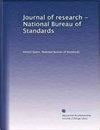Inorganic Trace Analysis by Isotope Dilution Mass Spectrometry—New Frontiers
Journal of research of the National Bureau of Standards
Pub Date : 1988-05-01
DOI:10.6028/jres.093.100
引用次数: 3
Abstract
Isotope dilution mass spectrometry (IDMS) is used extensively at NBS in the certification of elemental concentrations in Standard Reference Materials. It is regarded at NBS as a "definitive method," that is, a method of proven high accuracy. Since the theme of this symposium is accuracy in trace element analysis, it is appropriate to review the role IDMS plays in accurate inorganic analysis. The thesis of this paper is that mass spectrometry is a dynamic technique, marked by continuous productive activity and change, and that new mass spectrometric methods and new ionization techniques promise to make IDMS more general, more available, and more cost effective. Furthermore, I argue that the adoption of this technique by analytical laboratories outside of reference laboratories would do much to broaden the accuracy base of the world's measurements. In IDMS the quantity of an element present in a material is determined from the change produced in the isotopic composition of the element when a known amount of stable isotope (called a spike) is added. Thus, the technique is applicable to all elements with more than one stable isotope, or greater than 60 elements in the periodic table. In practice this number is reduced to those elements readily handled and ionized in the source of a mass spectrometer. In addition, some mononuclidic elements can be determined using radioactive isotopic spikes. For instance, procedures have been developed in our laboratory for iodine and thorium us-同位素稀释质谱法分析无机痕量物——新前沿
同位素稀释质谱法(IDMS)在国家标准局广泛用于标准参考物质中元素浓度的认证。国家统计局认为它是一种“确定的方法”,也就是说,一种被证明具有高准确性的方法。由于本次研讨会的主题是微量元素分析的准确性,因此有必要回顾一下IDMS在准确分析无机元素中的作用。本文的主题是质谱分析是一种动态技术,其特征是持续的生产活动和变化,新的质谱分析方法和新的电离技术有望使IDMS更普遍,更容易获得,更具成本效益。此外,我认为,在参考实验室之外的分析实验室采用这种技术将大大有助于扩大世界测量的准确性基础。在IDMS中,当加入已知数量的稳定同位素(称为尖峰)时,材料中存在的元素的数量由该元素同位素组成的变化来确定。因此,该技术适用于具有一个以上稳定同位素或元素周期表中大于60个元素的所有元素。实际上,这个数字被简化为质谱仪源中易于处理和电离的那些元素。此外,一些单核元素可以用放射性同位素尖峰测定。例如,我们的实验室已经开发了碘和钍的程序
本文章由计算机程序翻译,如有差异,请以英文原文为准。
求助全文
约1分钟内获得全文
求助全文

 求助内容:
求助内容: 应助结果提醒方式:
应助结果提醒方式:


